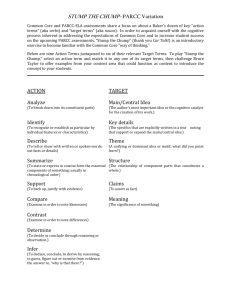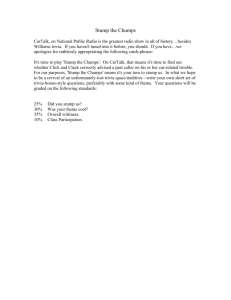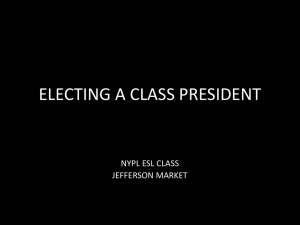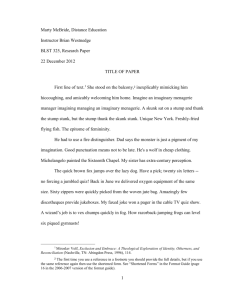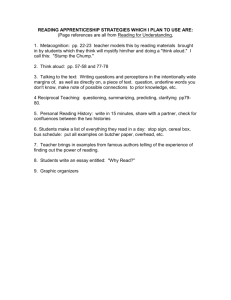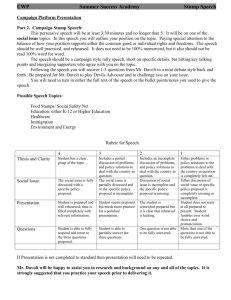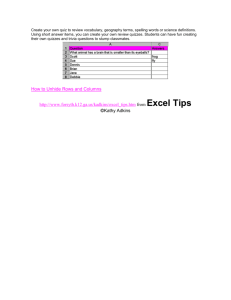Address America: Your Six-Word Stump Speech Lesson Plan About
advertisement
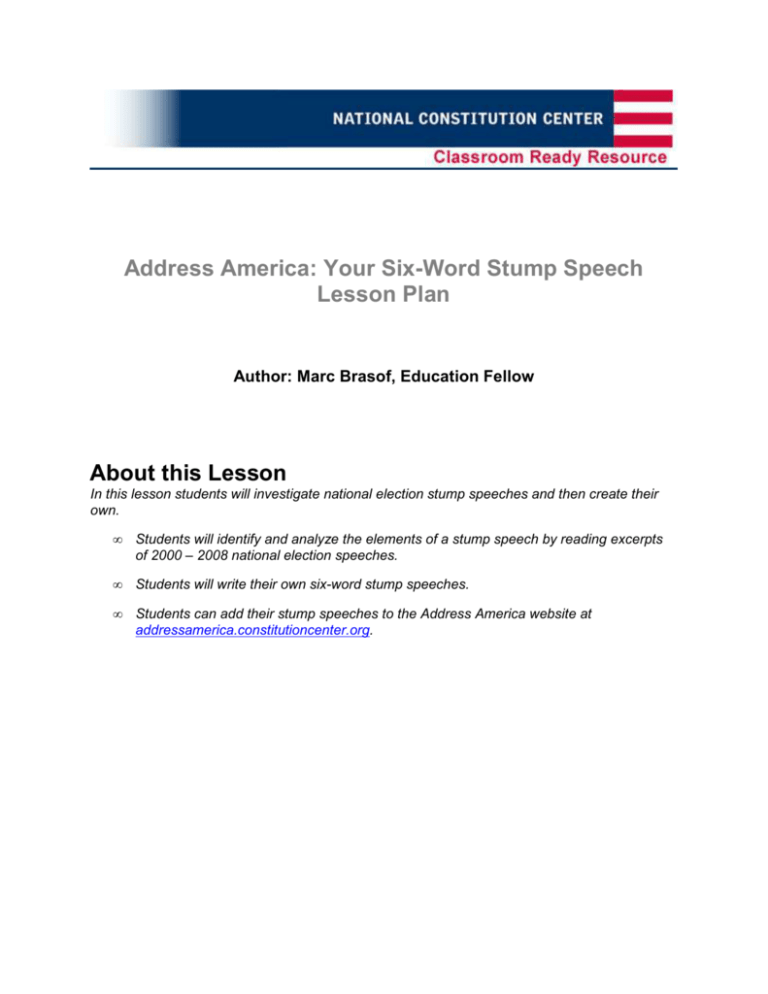
Address America: Your Six-Word Stump Speech Lesson Plan Author: Marc Brasof, Education Fellow About this Lesson In this lesson students will investigate national election stump speeches and then create their own. • Students will identify and analyze the elements of a stump speech by reading excerpts of 2000 – 2008 national election speeches. • Students will write their own six-word stump speeches. • Students can add their stump speeches to the Address America website at addressamerica.constitutioncenter.org. Address America Lesson Plan National Constitution Center Classr oom Ready Resour ce Grade(s) 6-12 Classroom Time 90 minutes Handouts Barack Obama’s Stump Speech Great Quotes Constitution Connections Articles II Amendments I Background Named in the nineteenth century after the act of a politician giving a campaign speech on top of a sawed-off tree stump, a stump speech is a standard, consistent message delivered several times a week to different audiences. The need for a stump speech stems from a desire for candidates to keep their message consistent with their political platform. When a politician writes a stump speech, he or she usually discusses their credentials, identifies their platform, compares him or herself to other candidates, and attempts to unify the electorate under a specific purpose. While the beginning of the speech is usually tweaked to include mentions of local people and other noteworthy events, most of the speech remains identical from day to day. Objectives Students will: • • • • Identify, apply, and analyze the basic elements of a stump speech Discuss how succinct and verbose speeches function differently in civic discourse Analyze phraseology used by politicians campaigning for national office Create a six-word stump speech Standards NCSS 1 Culture NCSS 4 Individual Development and Identity NCSS 5 Individuals, Groups, and Institutions NCSS 10: Civic Ideals and Practices © 2 0 1 2©2006 N a t National i o n a l Constitution C o n s t i t uCenter tion Center Page |2 Address America Lesson Plan National Constitution Center Classr oom Ready Resour ce Activity 1. The Anatomy of a Stump Speech. Use The Washington Post’s Anatomy of a Stump Speech to identify and analyze the different parts of Senator Barack Obama’s 2008 Presidential campaign stump speech. The Further Resources section also has links which allow students to listen to and read full election stump speeches and analyses. Ask students to: a. Identify when Obama discusses his credentials and platform, compares himself to other candidates, and attempts to unify electorate under a specific purpose. b. Which words stood out to you most? c. What literary devices does Obama use to convey his message? d. What themes does Obama evoke in this speech? e. Do you think he is speaking to a particular group of people at different points in the speech? How can you tell? f. What are ways in which verbosity (long-windedness) can become succinct and why is that important? g. Although this speech was delivered in 2008, is it still relevant today? Discuss. 2. Create your Six-Word Stump Speech. Ernest Hemingway was once challenged to write a short story in only six words. He responded by writing “For sale: baby shoes, never worn.” In this next set of activities, students will create a six-word stump speech as if they were given five seconds to sum up their presidential speech. Students will first look at popular quotes from recent stump speeches and discuss their meanings and then collectively discuss possible words and phrases for their own six-word stump speeches. a. Students will look at examples six word stump speeches using the Great Quotes Handout. Either cut this handout and distribute one quote for every two students or give each student a copy of all the quotes. Ask students to read their quotes and discuss with a partner: i. What does this quote mean? ii. What do you think made this quote so powerful? What words or phrases would most resonate with you? b. Pretend that the current President, or a nominee, came to your school to give a speech in hopes of winning your vote. What issues do you believe are most pressing? In what direction should the country be going? When you picture the country four years from now, what do you see? Have students answer these questions by recording words, phrases, and images on a classroom chalkboard or whiteboard. To enrich this experience, create a word cloud using Wordle including all the words and phrases recorded on the board. Hold a class discussion using the following questions: i. Which words/phrases seem to stand out most to you? ii. Are there any words/phrases that are related to one another? iii. What themes seem to emerge? I.e. poverty, college, speech on-line, war, money, etc. c. Create your six-word stump speech. Have students think about these questions when forming their ideas: i. Where will you be speaking? ii. To whom will you be speaking? iii. Which aspect of the stump speech will you be writing? © 2 0 1 2©2006 N a t National i o n a l Constitution C o n s t i t uCenter tion Center Page |3 Address America Lesson Plan National Constitution Center Classr oom Ready Resour ce • credentials • platform • comparisons to other candidates • attempt to unify electorate under a specific purpose iv. What is an important issue that you want to address? Write a 2 to 3 sentence explanation and then try to circle/underline the most salient points and edit out redundancy. v. When people discuss your speech later, what do you want them to say or take away? 3. Submit a Six-Word Stump Speech to the Center’s Address America Website a. Visit http://addressamerica.constitutioncenter.org/ to experience the excitement behind the 2012 election and be a part of the Center’s civic engagement project Address America: Your Six-Word Stump Speech. b. Students can submit their speech online and share with others via social media. c. Students can then view recently submitted speeches, see which are most popular, and view speeches by issue. d. Students can also remix their submissions along with submissions of other users, sort and view six words in dynamic ways, and connect to more information about the election, candidates and the Constitution. Assessment Options 1. Have students create a campaign poster that includes their six-word stump speech. 2. Students can verbally deliver their six-word stump speech in front of the entire class. Organize the speaking order based on which aspect of the stump speech they created. Further Resources The New York Times’ Anatomy of a Stump Speech 2008: http://elections.nytimes.com/2008/president/candidates/stump-speeches/mccain.html 2012: http://www.nytimes.com/interactive/2012/01/03/us/politics/gop-stump-speeches.html The Washington Post’s Anatomy of Barack Obama’s Stump Speech http://www.washingtonpost.com/wp-dyn/content/graphic/2008/02/26/GR2008022600417.html Address America: Your Six-Word Stump Speech: http://addressamerica.constitutioncenter.org/ © 2 0 1 2©2006 N a t National i o n a l Constitution C o n s t i t uCenter tion Center Page |4 Address America Lesson Plan National Constitution Center Classr oom Ready Resour ce Great Quotes Handout “Have faith that right makes might.” – Abraham Lincoln, 1860 “Federal government is overgrown and overweight.” – Ronald Reagan, 1980 “Restore America to its own people.” – Franklin D. Roosevelt, 1932 “Time has come for honest government.” – Richard Nixon, 1968 “Our government should work for us.” – Barack Obama, 2008 “It’s special interests against the people.” – Harry S Truman, 1948 “Opportunity for all, responsibility from all.” – Bill Clinton, 1996 “The old ways will not do.” – John F. Kennedy, 1960 “Read my lips: no new taxes.” – George H.W. Bush, 1988 © 2 0 1 2©2006 N a t National i o n a l Constitution C o n s t i t uCenter tion Center Page |5
